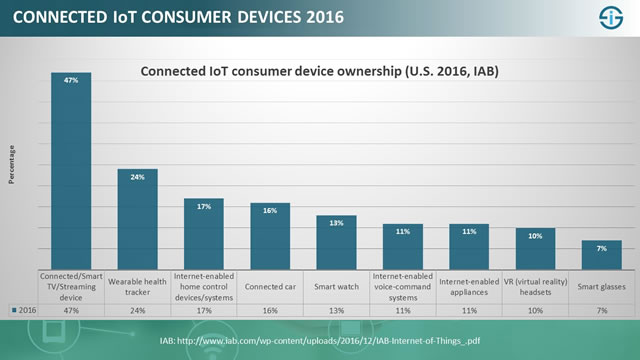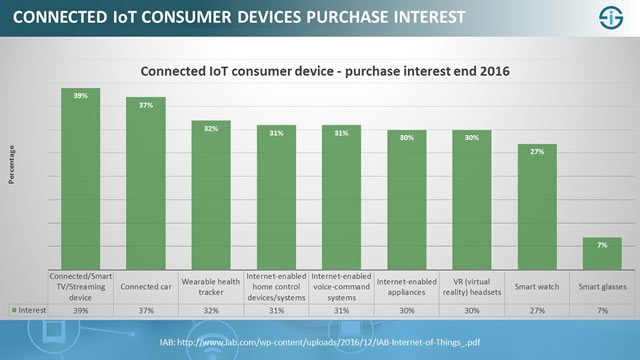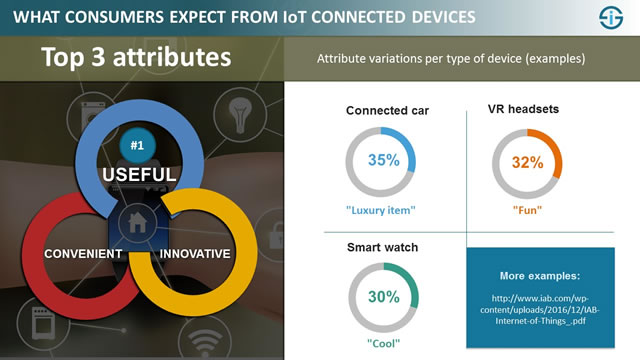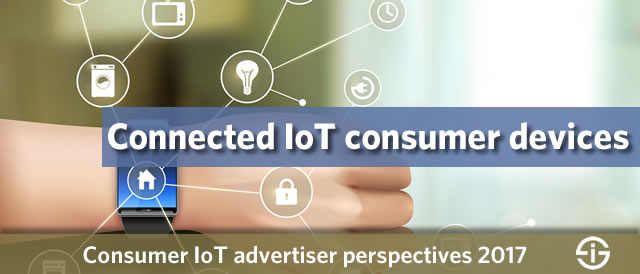Research, conducted by MARU VCR&C on behalf of the IAB, shows the Internet of Things device ownership and buying interests of American consumers, while looking at the advertising opportunity on the screens of IoT-connected devices.
When the IAB (Interactive Advertising Bureau) publishes a report on any given topic you know that the ad industry is preparing itself to jump on that topic. The next advertising opportunity at hand if we look at a December 15, 2016 IAB report: the Internet of Things.
We’ve mentioned before how the Internet of Things, de facto mainly the Consumer Internet of Things (CIoT) segment in that big IoT reality (which has become a ‘thing’ and umbrella term) can obviously be leveraged for marketing purposes. We also advised to have a focus beyond just real-time messaging and campaigns. After all, marketing is about more than that and the main benefits which can be realized with a smart Internet of Things strategy with a consumer-oriented focus aren’t exactly about ads and should be looked upon from an integrated perspective in the broader IoT marketing sense.
Advertising on connected devices: consumer willingness
However, we know that this message won’t matter that much and it’s a bit of a dream to think the Consumer Internet of Things and connected device space will be about creating genuine customer-centric value beyond ads and communications.
Let’s face it: we saw the same with content marketing, which de facto quickly became branded content and native advertising, once the ad industry and the IAB started getting active in a domain that primarily was (and still should be) an integrated and customer-centric one instead of about paid content placement. But it is what it is.
So, after content marketing, data, programmatic and the likes, the advertising industry body is now looking at those screens of connected IoT consumer devices near you, preferably very near you, across all connected devices, wherever you are and at whatever time. Hyper-personalization, we are told, is what we want as consumers because personalized ads make us happier.
The advertising industry will be glad to hear that, according to the IAB study, 65 percent of American owners of connected devices (and we do mean IoT-enabled or IoT-connected devices, not connected devices overall) say they are willing to receive ads on IoT screens.
Note that the research only looks at the IoT-connected devices which we own as consumers. When we mentioned hyper-personalization we also meant personalized messages via IoT-enabled digital signage, IoT-enabled screens in retail, on future IoT-enabled devices such as fuel dispensers, you name it. There is a lot that can be and will be connected.
The IoT consumer device owner and marketer quid pro quo
Their “being willing to receive ads on IoT screens” doesn’t necessarily mean that respondents want them but they are willing to, as usual in exchange for something else, depending on the context.
In that old ‘quid pro quo’ marketer-consumer relationship, it’s important to remind that what consumers like in exchange doesn’t need to be ad or a coupon. The quid quo pro between utilities and consumers, for instance, can also be about data in exchange for cheaper energy bills and, for those who are conscious regarding the environment, more effective natural resources ‘management’. Choice and control are two terms we should never forget in this equation.
It’s not just the owners of Internet of Things connected devices that are willing to see ads on an IoT screen.
The research also found that 55 percent of U.S. adult respondents overall say they would be willing to see ads on connected devices in exchange for an offering such as a coupon (44 percent), additional features (30 percent) or access to exclusive games (19 percent), regardless of whether they already have a connected device or not.
This brings us to the question what types of IoT devices Americans consumers have and which connected devices they would buy.

The ownership of IoT consumer devices today and interests for tomorrow
According to the MARU VCR&C study, conducted among 1,200 consumers, a rather impressive 62 percent of American consumers today already own at least one IoT-connected device.
However, the largest majority of owned devices consists of rather traditional and early-stage categories, while newer categories which are more independent from other devices (e.g. from smartphones), such as smart wearables that are closer to the essence of the Consumer Internet of Things, are less prominent.
The top 5 of most popular owned connected IoT consumer devices consist of, respectively:
- Connected/smart TVs and streaming devices, by far the most popular category (47 percent).
- Wearable health trackers, in practice mainly fitness and activity trackers such as FitBit and Jawbone (24 percent).
- Internet-enabled home control devices and systems, including home security, smart thermostats, etc. (17 percent).
- Connected car which is a broad concept here and includes all connected car devices that have Internet access and can be used with other devices (16 percent).
- Smart watches, remarkably limited and also including first generation smart watches with limited functionality and smartphone dependency (13 percent).
The top 5 desired connected IoT consumer devices
The top 5 categories from a connected device purchase interest perspective looks different with:
- Connected/smart TVs and streaming devices holding the first spot here as well (39 percent) but with
- Connected car on the second spot (37 percent), and
- Wearable health trackers being pushed back to the third spot (32 percent). No smart watches to be seen in the top of purchase interest, as
- Internet-enabled home control devices and systems rank fourth (31 percent), this sharing the same percentage of interest with
- Internet-enabled voice command systems which rank fifth with 31 percent too and enter the top 5
Note: these connected device purchase interest percentages group respondents who are aware of the ‘devices’ but don’t own then and have answered that they are very or somewhat interested to buy. In other words: it’s certainly not the same as actual purchase intent.
Nevertheless: interesting data if that interest becomes reality as it clearly shows consumers are getting more interested in the newer and more advanced categories of connected devices.

Brands should watch the space, test, understand and be realistic
If we look at the profiles of those who own most connected devices we can’t but mention again how it’s still relatively early days for the Internet of Things, certainly in a Consumer IoT context.
The real action today is in the Industrial Internet of Things which is an entirely different ball game and hardly related with the space of connected consumer electronics devices.
Still, according to IAB COO Patrick Dolan, brands need to watch the space as consumers are familiar with connected devices and increasingly own one or more. This obviously has an impact that will grow as Consumer IoT maturity and adoption grow. And here the consumer interest seems like a good sign.
With the IoT security woes that were widely commented in the second half of 2016 it’s to be seen if growth will be fast. Early 2016, Accenture already pointed out that security and lack of a ‘wow’ factor are withholding consumers for now.
The attributes of IoT devices that appeal to consumers
Vendors can by the way find some other attributes consumers like from their IoT connected devices in the IAB Internet of Things study.
While usefulness, convenience and innovative are the top 3 attributes, also make sure to look at the variations per type of device (note: if you miss some growing categories, the report defined the categories respondents come pick from). In the graphic below you see some of the attribute variations per type of device but the report has several more.

What the impact of the security focus in traditional media will be, is still to be seen and we’ll see soon enough at the beginning of 2017 when people have unpacked their gifts. Will Santa bring socks or a VR headset?
In the meantime advertisers are already working with connected devices in the broadest sense. Personalized advertising (based upon viewing behavior for instance) on smart and less smart TVs isn’t really new. Concerning those other screens: keep in mind that the link between many of the current IoT devices and smartphones will change and that, although cross-anything will be important, advertising across all those future screens might not be the best marketing, let alone customer-facing activity, around.
Top image: Shutterstock – Copyright: Macrovector – All other images are the property of their respective mentioned owners.


